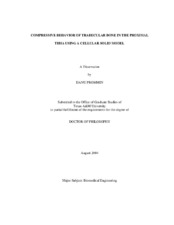Compressive behavior of trabecular bone in the proximal tibia using a cellular solid model
| dc.contributor.advisor | Hyman, William A. | |
| dc.creator | Prommin, Danu | |
| dc.date.accessioned | 2005-11-01T15:49:11Z | |
| dc.date.available | 2005-11-01T15:49:11Z | |
| dc.date.created | 2004-08 | |
| dc.date.issued | 2005-11-01 | |
| dc.identifier.uri | https://hdl.handle.net/1969.1/2679 | |
| dc.description.abstract | In this study, trabecular architecture is considered as a cellular solid structure, including both intact and damaged bone models. ??Intact?? bone models were constructed based on ideal versions of 25, 60 and 80-year-old specimens with varying trabecular lengths and orientations to 5%, and 10% covariance of variation (COV). The models were also flipped between longer transverse and longer longitudinal trabeculae. With increasing COV of lengths and orientations of trabecular bone, the apparent modulus is linearly decreased, especially in the longer transverse trabeculae lengths. ??Damaged?? bone models were built from the 25 year old model at 5% COV of longer transverse trabeculae, and with removing trabeculae of 5% and 10% of trabecular volume in transverse and longitudinal directions, respectively, as well as in combination to total 10% and 15%. With increasing percent of trabeculae missing, the apparent modulus decreased, especially dramatically when removal was only in the transverse direction. The trabecular bone models were also connected to a cortical shell and it was found that the apparent modulus of an entire slice was increased in comparison to the modulus of trabecular bone alone. We concluded that the architecture of trabecular bone, especially both lengths and percent of trabecular missing in the longitudinal direction, significantly influences mechanical properties. | en |
| dc.format.extent | 1242773 bytes | en |
| dc.format.medium | electronic | en |
| dc.format.mimetype | application/pdf | |
| dc.language.iso | en_US | |
| dc.publisher | Texas A&M University | |
| dc.subject | trabecular bone | en |
| dc.subject | compressive behavior | en |
| dc.subject | cellular solid | en |
| dc.subject | proximal tibia | en |
| dc.subject | trabecular architecture | en |
| dc.title | Compressive behavior of trabecular bone in the proximal tibia using a cellular solid model | en |
| dc.type | Book | en |
| dc.type | Thesis | en |
| thesis.degree.department | Biomedical Engineering | en |
| thesis.degree.discipline | Biomedical Engineering | en |
| thesis.degree.grantor | Texas A&M University | en |
| thesis.degree.name | Doctor of Philosophy | en |
| thesis.degree.level | Doctoral | en |
| dc.contributor.committeeMember | Hulse, Donald | |
| dc.contributor.committeeMember | Wu, Hsin-i | |
| dc.contributor.committeeMember | Criscione, John C. | |
| dc.type.genre | Electronic Dissertation | en |
| dc.type.material | text | en |
| dc.format.digitalOrigin | born digital | en |
Files in this item
This item appears in the following Collection(s)
-
Electronic Theses, Dissertations, and Records of Study (2002– )
Texas A&M University Theses, Dissertations, and Records of Study (2002– )


